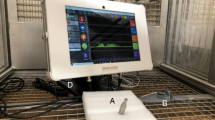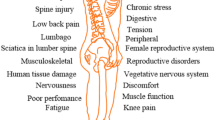Abstract
The noise level in an animal facility is an important environmental variable that can adversely affect animal welfare, as well as experimental data. The authors describe the strategy they used to record, evaluate, and control excess noise and vibration during a period of renovation, while maintaining the operation of a research facility.
This is a preview of subscription content, access via your institution
Access options
Subscribe to this journal
We are sorry, but there is no personal subscription option available for your country.
Buy this article
- Purchase on Springer Link
- Instant access to full article PDF
Prices may be subject to local taxes which are calculated during checkout



Similar content being viewed by others
References
Animal Welfare Act 1966 (7 USC, 2131–2157), as Amended 1970, 1976, 1985. http://www.aphis.usda.gov/ac/awapdf.pdf.
Institute of Laboratory Animal Resources, National Research Council. Guide for the Care and Use of Laboratory Animals 36 (National Academy Press, Washington, DC, 1996).
Animal Welfare Act Regulations and Standards, Code of Federal Regulations, Title 9, Part 2—Regulations, Sections 2. 31–2.33, 2.38, and 3.8–3.81. Revised as of April 25, 2001. http://www.aphis.usda.gov/ac/publications.html.
Milligan, S.R., Sales, G.D. & Khirnykh, K. Sound levels in rooms housing laboratory animals: an uncontrolled daily variable. Physiol. Behav. 53, 1067–1076 (1993).
ASHRAE. In Handbook of Facilities Planning Vol. 2, ASHRAE Applications Handbook 167–171 (American Society of Heating, Refrigeration and Air-Conditioning Engineers, Atlanta, 1995).
Lindquist, K. Compilation of Noise and Vibration Studies—Module 1. Acentech Final Report (2001), submitted to FDA August 2, 2001.
Anonymous. FDA MOD-I Facility Noise and Vibration Monitoring. Wyle Laboratories Final Report (2002), submitted to FDA July 31, 2002.
Bjork, E., Nevalainen, T., Hakumaki, M. & Vorpio, H.M. R-weighting provides better estimation for rat hearing sensitivity. Lab. Anim. 34, 136–144 (2000).
Sales, G.D., Wilson, K.J., Spencer, K.E. & Milligan, S.R. Environmental ultrasound in laboratories and animal houses: a possible cause for concern in the welfare and use of laboratory animals. Lab. Anim. 22, 369–375 (1988).
ACGIH. 2000 TLV's and BEI's Threshold Limit Values for Chemical Substances and Physical Agents and Biological Exposure Indices 111–133 (American Conference of Governmental Industrial Hygienists, Cincinnati, 2000).
OSHA Regulations (Standards—29CFR), Occupational Noise Exposure—1926.52 (d)(1); (d)(2)(i).
Okada, A. Physiological responses of the rat to different vibration frequencies. Scand. J. Work Environ. Health 12, 362–364 (1986).
ANSI. Guide for the Evaluation of Human Exposure to Whole Body Vibration. ANSI S3.18. (American National Standards Institute, New York, l979).
ANSI. Guide for the Evaluation of Human Exposure to Whole Body Vibration in Buildings. ANSI S3.29 (American National Standards Institute, New York, 1985).
Acknowledgements
The authors thank the FDA's Division of Facility Planning, Engineering and Safety, and the many contract office, line management, FDA facility management, and administrative personnel associated with the CDER and CFSAN research animal programs who contributed their time, effort and resources in the formulation and implementation of a coordinated strategy to address the concerns about construction-related noise and vibration. We also thank Chugach Support Services, Kling Lindquist, Acentech, DynCorp, and Wyle Laboratories for their cooperation.
Author information
Authors and Affiliations
Corresponding author
Rights and permissions
About this article
Cite this article
Sobotka, T., Harper, S., Hanig, J. et al. Strategy for Controlling Noise and Vibration During Renovation of an Animal Facility. Lab Anim 32, 34–40 (2003). https://doi.org/10.1038/laban0803-34
Received:
Accepted:
Issue Date:
DOI: https://doi.org/10.1038/laban0803-34



